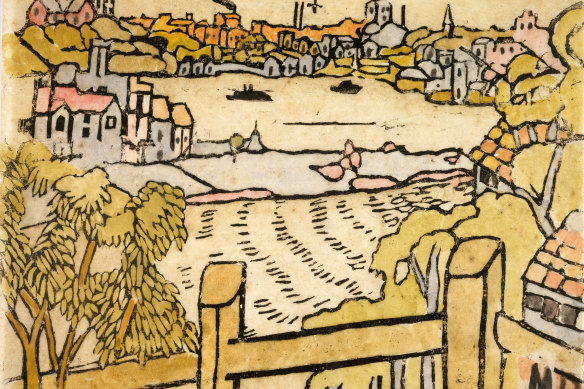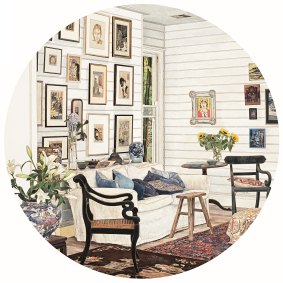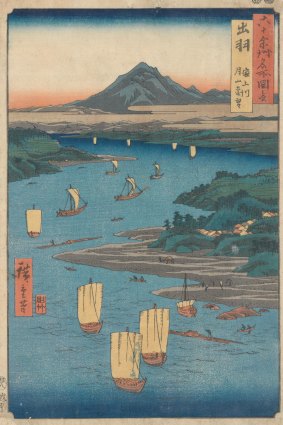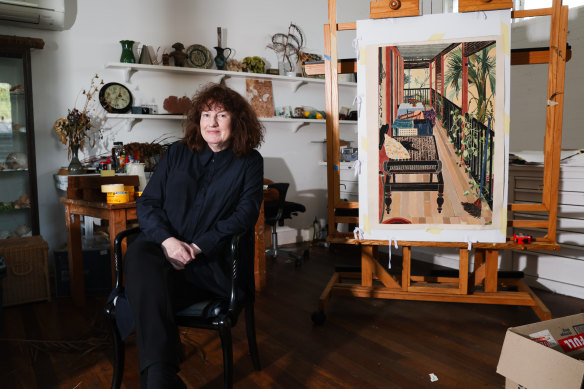Two of Australia’s great artists lead exhibition full of echoes
Cutting Through Time is an artful title for an innovative exhibition at the Geelong Art Gallery that explores affinities between Cressida Campbell, Margaret Preston, and the great Japanese printmakers of the Ukiyo-e school. It’s yet another instance in which a Victorian gallery is surveying the work of artists firmly associated with Sydney. At the opening, Campbell confessed it was the first time she’d ever been in Geelong. I have no idea if Margaret Preston visited Victoria’s second city, but I’m pretty confident it remained terra incognita to Hokusai, Hiroshige and Utamaro.
The major selling point for the Geelong exhibition is Cressida Campbell, who has become one of the few certified crowd-pullers in contemporary Australian art. Ironically, she has attained this status after so many years of being ignored by public galleries that found her insufficiently avant-garde. Most of her works in state and regional collections were donated by Margaret Olley, who knew a good thing when she saw it. Now the galleries complain that a major picture by Campbell is too expensive, when they could have acquired dozens for relatively modest prices.

Margaret Preston’s Mosman Bay (1920).
She remains unrepresented in Australia’s biggest public collection, the National Gallery of Victoria, which suggests she still has ground to make up south of the border. The Geelong exhibition, which follows on from the artist’s National Gallery of Australia retrospective of 2022-23, is a big step in this direction.
Curator Lisa Sullivan has worked hard to find connections between Campbell’s idiosyncratic method of printmaking, which produces a single coloured print and a painted block; the woodblock prints of Margaret Preston (1875-1963), and those Japanese artists of the 17th-19th centuries who have exerted an influence on both Australians.
The catalogue reveals a few credible visual echoes across time, in a double page spread which juxtaposes Hiroshige’s Distant View of Moon Mountain from Mogai River (1853-56) with Preston’s The Boat, Sydney Harbour (c.1920). Another spread puts Campbell’s triptych, Breakfast at Armidale (1988), alongside Hiroshige’s three-panel landscape, Kasumigaseki (1835-39), a work from her personal collection.

Cressida Campbell’s Journey Around My Room (2019).
In both cases, there are compositional similarities that are only noticeable when one looks from one work to the other. This isn’t possible in the exhibition itself as it is divided into three separate galleries for Campbell, Preston and the Japanese artists. It’s up to the viewer to carry their observations from one room to the next.
In their admiration for the Ukiyo-e – “floating world” - printmakers, Preston and Campbell are following in some illustrious footsteps. Claude Monet owned 231 Japanese prints. Van Gogh absorbed the Ukiyo-e legacy so completely that upon arriving in Arles he wrote to Emile Bernard: “This country seems to me as beautiful as Japan as far as the limpidity of the atmosphere and the gay colour effects are concerned.” He knew Japan only through its prints.
Best of all was Camille Pissarro, who wrote to his son Lucien, saying what he liked so much about these works: “Nothing that leaps to the eye, a calm, a grandeur, an extraordinary unity, a rather subdued radiance.”
What both Preston and Campbell have learned from the Ukiyo-e printmakers is a kind of visual grammar. This may be seen in images divided by a tree or pole in the foreground, or in compositions that resemble snapshots in their apparent informality. These images are the antithesis of the classical landscape in which every element is laid down in orderly recession. In Preston’s work the prints helped fuel her personal brand of Modernism, which was cross-pollinated with a healthy dose of Arts & Crafts.

Utagawa Hiroshige’s Distant View of Moon Mountain from Mogami River, Dewa Province (1856).
By nature, Preston was the most restless of artists, constantly experimenting and changing tack. Her landscapes such as The Boat, Sydney Harbour or Mosman Bay (1920), may show the influence of the Japanese printmakers, but her still lifes can be rigidly symmetrical, plonking a vase of flowers in the centre of a panel. She is also prone to taking short cuts, having realised it’s much easier to print a simple black-and-white outline and colour it by hand than to follow the painstaking Ukiyo-e method of cutting different blocks for each colour. Not only is this time-consuming, it requires incredible precision. One positive result is that the hand-painting transforms each print into a unique artefact.
Campbell is a more patient craftswoman, and she seems to be growing increasingly fastidious with age. Ukiyo-e compositional ideas appear in almost all her works, be they still lifes, interiors or landscapes. By now it’s fair to say she has internalised these concepts to the point where they are purely instinctive. Unlike Preston (and filmmaker, Wes Anderson!), she has an antipathy for symmetry, which she sees as an unnatural sense of order imposed on a composition.
Preston was a dedicated proselytiser and self-publicist who liked to tell everyone about her discoveries and encourage them to follow her lead. The catalogue reprints her 1930 article from Art in Australia, titled Woodblocking as a Craft. As always with Preston there’s a touch of Mrs Beeton in her writing, as she provides instructions to the homemakers of Australia on how to make woodblock prints as original household decorations. It’s not something I can imagine Campbell doing.
The jury is still out – and will forever be out – as to whether Preston’s recommendation that one might borrow Aboriginal motifs as DIY home decorations was an outrageous cultural appropriation or an enlightened recognition of Indigenous art. Whenever Campbell includes an Aboriginal motif it’s a scrupulous copy of a work that hangs on her own walls. In the many interior studies she has produced without ever leaving the house, works of art, ceramics, textiles and other items are assigned an ideal equivalence as elements in a composition. Each of these pictures is an oblique self-portrait of the artist-as-collector. It wouldn’t make much sense to analyse the cultural associations of individual objects that have been chosen exclusively for their aesthetic value.

Artist Cressida Campbell.Credit: Edwina Pickles
The show includes three of the impressive circular interiors Campbell has produced in recent years, each one a portal onto a private world arranged to suit her personal taste. Works such as Black Room with Yellow Chrysanthemums (2021) and Journey Around My Room (2019) are like nothing else in Australian art. Painstakingly realistic, these pictures retain a tactility through the slightly chalky texture of the watercolours the artist uses to paint the block. They are anything but photographic.
These interiors are distant cousins of those paintings of the Royal Academy or the Paris Salon that show hundreds of individual works clustered on the gallery walls, but Campbell is not much interested in public spaces or occasions. Each scene is strictly hermetic, arranged with no less care than Giorgio Morandi would arrange those familiar jugs and bottles he never tired of painting.
Alongside Campbell’s work, even Preston’s most celebrated pieces such as Wheelflower (c. 1929), look simplistic and emblematic. Her prints are best seen in their proper historical context, as a challenge to those repetitive bush landscapes and brown portraits of men in suits that passed as important Australian art in the 1920s. Preston fought to drag Australian culture into the Modern era in the face of entrenched institutional resistance. Campbell’s work represents a very different ethos – a retreat from the political issues, the obsessions with race and gender, that have become all-important for so many of our contemporary institutions. In her work, the search for beauty counts for more than the search for identity. Find what you love, she seems to say, and the rest will fall into place.
Cutting Through Time: Cressida Campbell, Margaret Preston and the Japanese Print is at the Geelong Art Gallery until July 28.